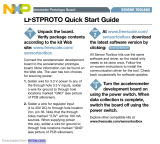
T W R - S 0 8 L L / L H U S E R G U I D E A P R I L 2 7 , 2 0 1 0
U S E R G U I D E
2
CONTENTS
CAUTIONARY NOTES .............................................................................................................. 4
TERMINOLOGY ......................................................................................................................... 4
FEATURES ................................................................................................................................ 5
GETTING STARTED .................................................................................................................. 6
MEMORY MAP .......................................................................................................................... 6
SOFTWARE DEVELOPMENT ................................................................................................... 6
DEVELOPMENT SUPPORT ...................................................................................................... 6
OSBDM BOOTLOADER........................................................................................................ 7
BDM_PORT HEADER ........................................................................................................... 7
EXTERNAL BDM CABLE .......................................................................................................... 7
POWER ...................................................................................................................................... 8
POWER SELECT .................................................................................................................. 8
V_SEL ............................................................................................................................... 8
VDD_EN ............................................................................................................................ 9
RESET SWITCH ........................................................................................................................ 9
LOW VOLTAGE RESET .......................................................................................................... 10
TIMING ..................................................................................................................................... 10
COMMUNICATIONS ................................................................................................................ 10
RS-232 ................................................................................................................................ 10
COM CONNECTOR ........................................................................................................ 11
COM_SEL ....................................................................................................................... 11
LCD .......................................................................................................................................... 11
ACCELEROMETER ................................................................................................................. 12
CONFIGURATION .............................................................................................................. 12
USER I/O .................................................................................................................................. 12
VDD1 ENABLE ................................................................................................................ 13
BUZZER .......................................................................................................................... 13
LIGHT SENSOR .............................................................................................................. 13
PUSHBUTTON SWITCHES ............................................................................................ 13
USER LED’S ................................................................................................................... 14
POTENTIOMETER .......................................................................................................... 14
DIFFERENTIAL ADC INPUT ........................................................................................... 15
EDGE CONNECTOR PIN-OUT ................................................................................................ 15



















